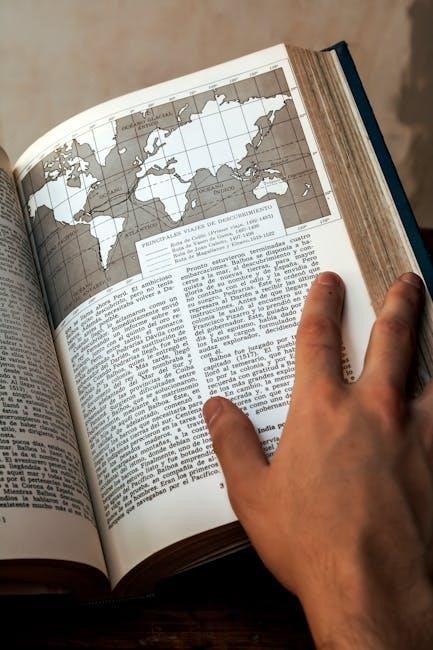Welcome to the study of macroeconomics, which examines the economy as a whole, focusing on issues like GDP, inflation, and economic growth․ This guide provides foundational concepts, key theories, and practical applications to help you master AP Macroeconomics․ Topics include scarcity, opportunity cost, and the circular flow model, essential for understanding economic systems and their interactions․
- Macroeconomics analyzes broad economic factors affecting society․
- Key concepts include GDP, national income, and price stability․
- Understanding these principles is crucial for the AP exam․
1․1 What is Macroeconomics?
Macroeconomics is the study of the economy as a whole, focusing on broad issues like GDP, inflation, and economic growth․ It examines the big picture, including national income, price levels, and the global economy, to understand how societies allocate resources and achieve economic goals like full employment and stability․
- Explores aggregates like total output and national income․
- Analyzes economic growth, inflation, and unemployment․
- Essential for understanding policy-making and global trends․
1․2 Key Economic Goals: Economic Growth, Full Employment, and Price Stability
Key economic goals include promoting economic growth, achieving full employment, and maintaining price stability․ Economic growth increases living standards, full employment ensures job availability for all willing workers, and price stability prevents inflation or deflation, fostering a stable economy․
- Economic growth enhances living standards․
- Full employment reduces unemployment rates․
- Price stability maintains purchasing power․
1․3 Basic Economic Concepts: Scarcity, Opportunity Cost, and Factors of Production
Scarcity arises from limited resources versus unlimited wants․ Opportunity cost is the value of the next best alternative foregone․ Factors of production—land, labor, capital, and entrepreneurship—are essential for creating goods and services, forming the foundation of economic activity and decision-making․
- Scarcity drives economic choices and trade-offs․
- Opportunity cost reflects the value of alternatives․
- Factors of production enable economic output․

Measurement of Economic Performance
Measuring economic performance involves assessing GDP, inflation rates, and national income․ These indicators provide insights into a nation’s economic health and growth trends․
2․1 Gross Domestic Product (GDP) and National Income
GDP measures the total value of final goods and services produced within a country’s borders, while national income includes all income earned by a nation’s citizens․ Both are crucial for assessing economic performance and growth․
2․2 Calculating GDP: Expenditure and Income Approaches
GDP can be calculated using the expenditure approach, which sums consumption, investment, government spending, and net exports (C + I + G + (X ー M))․ Alternatively, the income approach adds up wages, rents, interest, and profits (W + R + I + P)․ Both methods provide a comprehensive measure of economic output․
2․3 Price Levels and Inflation Rate Measurements
Price levels measure the overall price of goods and services in an economy․ Inflation rates are calculated using indices like the Consumer Price Index (CPI) or the GDP deflator․ The CPI tracks consumer goods prices, while the GDP deflator includes all goods and services․ Inflation rate is the percentage change in price levels over time․

Economic Growth and Development
Economic growth refers to an increase in a nation’s production capacity, measured by GDP per capita․ Development encompasses improvements in living standards, health, education, and overall well-being․
3․1 Determinants of Economic Growth
Economic growth is influenced by factors such as technological advancements, institutional frameworks, and policy decisions․ Technological progress enhances productivity, while stable institutions and supportive policies foster innovation and investment․ Additionally, human capital and natural resources play significant roles in sustaining long-term economic expansion and development․
- Technological advancements boost productivity․
- Institutions and policies create a favorable environment․
- Human capital and resources drive growth․
3․2 Theories of Economic Growth
Theories of economic growth explain how economies expand over time․ The Solow Growth Model emphasizes technology and capital accumulation, while Endogenous Growth Theory highlights human capital, innovation, and knowledge․ These frameworks help understand the drivers of long-term prosperity and development․
- Solow Growth Model: Focuses on technology and capital․
- Endogenous Growth Theory: Emphasizes human capital and innovation․
3․3 Policies to Promote Economic Growth
Policies to promote economic growth include fiscal measures like increased government spending or tax cuts, and monetary policies such as lowering interest rates․ Supply-side policies, such as tax incentives for businesses, aim to enhance productivity and investment․ These strategies stimulate economic activity and foster sustainable development․
- Fiscal policy: Government spending and tax adjustments․
- Monetary policy: Central bank actions on interest rates․
- Supply-side policies: Incentives for productivity and investment․

Inflation and Unemployment
Inflation and unemployment are critical macroeconomic concepts․ Inflation refers to rising price levels, while unemployment measures joblessness․ Understanding their causes, types, and impacts is essential for analyzing economic stability and policy responses․
- Inflation: Sustained increase in general price levels․
- Unemployment: Percentage of labor force without jobs․
- Both affect economic well-being and policy decisions․
- Frictional: Temporary job transitions or new entrants․
- Structural: Skill or technological mismatches․
- Cyclical: Economic downturns and reduced demand․
- Inflation reduces purchasing power and savings value․
- Unemployment decreases consumer spending and economic output․
- Both disrupt economic stability and hinder growth․
- Trade promotes economic growth and efficiency․
- Exchange rates impact trade balances․
- Trade policies influence economic outcomes․
- Specialization boosts productivity and efficiency․
- Trade lowers prices and expands consumer choices․
- Job displacement and inequality can occur․
- Supply and demand in foreign exchange markets․
- Relative inflation rates and interest rates․
- Trade balances and capital flows․
- Tariffs and quotas: tools for protecting domestic industries․
- Free trade agreements: fostering economic cooperation and reducing barriers․
- Trade balances and exchange rates: key factors in policy outcomes․
- Utilize practice tests for self-assessment;
- Review economic terms and theories thoroughly․
- Develop effective test-taking strategies․
- Use flashcards for key terms․
- Engage in active learning through discussions․
- Allocate time for concept-based practice problems․
- Scarcity: Limited resources vs․ unlimited wants․
- Opportunity Cost: Value of the next best alternative․
- GDP: Measures economic output․
- Practice tests simulate real exam conditions․
- Flashcards aid in memorizing key terms․
- Review materials enhance concept retention․
4․1 Types and Causes of Inflation
Inflation is categorized into demand-pull, cost-push, and built-in inflation․ Demand-pull occurs when aggregate demand exceeds supply, driving up prices․ Cost-push results from rising production costs, such as higher wages or material prices․ Built-in inflation stems from expectations of future inflation, leading to higher wages and prices․ Understanding these causes helps in formulating effective monetary and fiscal policies to stabilize the economy and maintain price stability, which is crucial for sustainable economic growth and employment․
4․2 Types and Causes of Unemployment
Unemployment is classified into frictional, structural, and cyclical types․ Frictional arises from job transitions or new entrants․ Structural results from skill mismatches or technological changes․ Cyclical unemployment occurs during economic downturns, caused by reduced aggregate demand․ Understanding these types helps in designing policies to mitigate joblessness and promote economic stability․
4․3 The Impact of Inflation and Unemployment on the Economy
Inflation erodes purchasing power, while unemployment reduces consumer spending, both weakening economic stability․ High inflation leads to uncertainty, discouraging investment, and unemployment increases poverty and inequality, lowering overall economic output and growth potential․

Aggregate Demand and Supply
Aggregate demand and supply models explain economic fluctuations, helping analyze the overall level of economic activity․ Understanding these concepts is key to grasping macroeconomic policies and their impacts․
5․1 The Aggregate Demand Curve
The aggregate demand curve shows the relationship between the price level and the quantity of goods and services demanded․ It slopes downward, reflecting the inverse relationship between prices and purchasing power․ Shifts occur due to changes in factors like consumption, investment, government spending, and net exports․
5․2 The Aggregate Supply Curve
The aggregate supply curve represents the total quantity of goods and services producers are willing to sell at different price levels․ It slopes upward, reflecting increasing production costs as output rises․ Shifts in the curve occur due to changes in resource prices, technology, or expectations, impacting the economy’s productive capacity․
5․3 Equilibrium in the Aggregate Demand and Supply Model
Equilibrium occurs where the aggregate demand curve intersects the aggregate supply curve, balancing the total quantity of goods and services demanded with those supplied․ Changes in demand or supply shift the curves, altering equilibrium levels of output and prices, ensuring market balance and resource allocation efficiency in the economy․

Fiscal Policy
Fiscal policy involves government spending and taxation to influence economic activity, aiming to achieve economic growth, full employment, and price stability․ It is a critical tool for managing aggregate demand and addressing economic fluctuations, making it a key topic in AP Macroeconomics studies․
6․1 Government Spending and Taxation
Government spending and taxation are primary tools of fiscal policy․ Spending injects money into the economy, stimulating demand, while taxes reduce disposable income․ Both influence aggregate demand and economic stability․ Understanding their effects is crucial for AP Macroeconomics, as they directly impact GDP and employment levels․ Effective use of these tools helps achieve economic goals․
6․2 The Multiplier Effect
The multiplier effect occurs when an initial change in spending leads to a larger overall change in economic output․ For example, government investment in infrastructure increases incomes, leading to additional consumer spending, thereby amplifying the initial impact․ This concept is crucial for understanding how fiscal policies can stimulate economic growth and stabilize economies during downturns․
6․3 Fiscal Policy Tools and Their Effects
Fiscal policy employs government spending and taxation to manage economic stability․ Tools include expansionary policies, such as increased spending or tax cuts, to boost demand during recessions, and contractionary policies to reduce inflation․ Understanding these tools is essential for analyzing their impacts on GDP, employment, and overall economic health․

Monetary Policy
Monetary policy, managed by central banks, uses tools like interest rates and money supply to influence inflation and economic stability․ Understanding its effects is key for AP Macroeconomics․
7․1 The Role of the Central Bank
The central bank plays a crucial role in implementing monetary policy, regulating money supply, and maintaining financial stability․ It sets interest rates and manages inflation, ensuring economic growth and stability․ Key tools include open market operations and reserve requirements․ Understanding its functions is vital for AP Macroeconomics success․
7․2 Tools of Monetary Policy: Interest Rates and Money Supply
Central banks use interest rates and money supply to regulate economic activity․ Lowering interest rates stimulates borrowing and spending, while raising them curbs inflation․ Adjusting the money supply through open market operations or reserve requirements influences liquidity and economic stability․ These tools are key in achieving macroeconomic goals like full employment and price stability․
7․3 The Effects of Monetary Policy on the Economy
Monetary policy significantly impacts inflation, employment, and economic growth․ Expansionary policies lower interest rates, stimulating investment and consumption, while contractionary policies reduce inflation by tightening money supply․ The effectiveness depends on economic conditions, with potential lags in implementation and outcomes․ Balancing these tools is crucial for achieving stable economic growth and price stability․

International Trade and Finance
International trade enhances economic efficiency through specialization and comparative advantage, while finance involves exchange rates and trade balances․ Understanding these concepts is vital for analyzing global economic interactions and policies․
8․1 Benefits and Costs of International Trade
International trade allows countries to specialize, increasing efficiency and lowering prices through comparative advantage․ It fosters economic growth, enhances competition, and provides diverse goods․ However, it may lead to job losses, trade imbalances, and environmental concerns, highlighting the need for balanced policies to maximize benefits and mitigate costs․
8․2 Exchange Rates and Their Determination
Exchange rates, the price of one currency in terms of another, are influenced by supply and demand, trade balances, inflation rates, and interest rates․ Strong economic indicators attract investment, appreciating the currency, while weaker ones depreciate it․ Understanding exchange rate dynamics is key for international trade and financial stability․
8․3 International Trade Policies and Their Impacts
International trade policies, such as tariffs, quotas, and trade agreements, influence global commerce․ Protectionist measures shield domestic industries but may spark trade wars, while free trade agreements promote economic interdependence․ These policies impact trade balances, consumer prices, and economic growth, shaping global markets and national economies․

Exam Preparation and Review
Master AP Macroeconomics with strategic study guides, practice tests, and comprehensive reviews․ Focus on key concepts, graphs, and formulas to excel on the exam․
9․1 Study Tips and Strategies for the AP Macroeconomics Exam
Develop effective study habits by breaking down complex concepts into manageable parts․ Regularly review graphs, formulas, and key economic theories․ Practice with past exams to familiarize yourself with the question format and timing․ Focus on understanding real-world applications of macroeconomic principles to enhance your problem-solving skills․ Stay organized and prioritize weak areas for improvement․
9․2 Key Economic Terms and Concepts to Know
Master essential terms like scarcity, opportunity cost, and factors of production․ Understand GDP, inflation, and unemployment; Grasp elasticity, aggregate demand, and supply․ Familiarize yourself with fiscal and monetary policies, exchange rates, and economic growth theories․ These concepts are vital for analyzing macroeconomic systems and acing the AP exam․
9․3 Practice Tests and Review Materials
Utilize practice tests and review materials to reinforce your understanding․ Full-length practice exams with answered questions help assess readiness․ Flashcards and study guides provide quick concept reviews․ Regular practice improves time management and familiarity with exam formats, ensuring confidence for the AP Macroeconomics exam․

No Responses